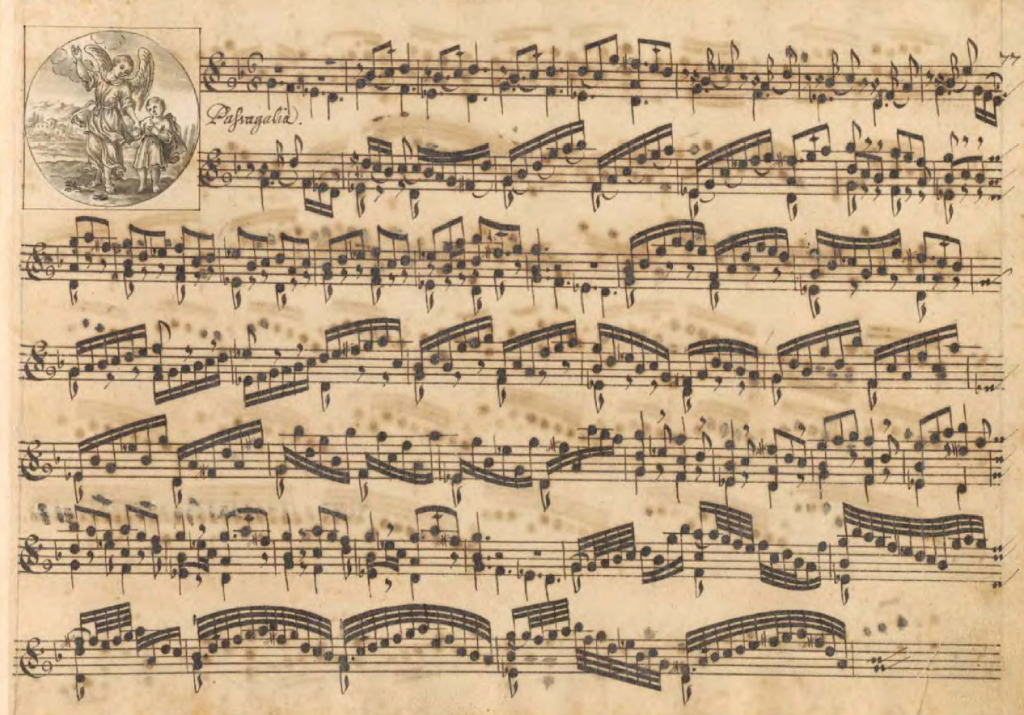by Daniel Hathaway

One of the most significant rediscoveries from the fascinating period when flights of fancy — dubbed the stylus fantasticus — dominated early Baroque music, Biber’s Rozenkranz-Sonaten lay hidden in the Bavarian State Library in Munich until they came to light in 1905.
That unique and beautiful manuscript from the 1670s contains fifteen solo violin sonatas and a concluding Passacaglia (below) by the prolific Biber, himself a virtuoso violinist. Identified only by a copperplate engraving illustrating its subject, each piece is a meditation on one of the sacred mysteries in the lives of Christ and the Virgin Mary.
Apollo’s Fire artistic director Jeannette Sorrell writes in the liner notes,
I waited over 25 years to record the Mystery Sonatas because I was waiting for the right violinist — a violinist who is a great storyteller, a spiritual soul, and a virtuoso who could master the extraordinary technical challenges of this music.
Enter Alan Choo, who joined the ensemble as a Young Artist Apprentice in 2007, and has made recording the Biber Sonatas a major, long-term project.
Those extraordinary technical challenges include Biber’s requirement that the soloist play violins with strings “mis-tuned” (scordatura) from the normal G-D-A-E pitches for 13 of the 15 sonatas, creating different resonances in the instrument for expressive purposes.
For somber subjects like “The Agony in the Garden,” the open strings play A-flat – E-flat – G – D, clashing pitches “evoking a sense of struggle,” as Choo writes. For triumphant subjects like “The Ascension,” the open strings are tuned to create a “glorious” C-Major chord. For the recording, Choo has used a total of six instruments to avoid constant retuning that would be destabilizing.
The violinist’s playing is extraordinary — as fresh and improvisatory as though he were composing each sonata on the spot, but also infused with an infectious emotional ardor.

As a continuo player myself, I have always felt that the extraordinarily imaginative writing in Biber’s masterpiece calls for an imaginative and colorful approach to the accompaniment.
Thus Choo’s superb supporting cast (pictured above) includes harpsichord (Sorrell), chamber organ (Peter Bennett), cello and viola da gamba (René Schiffer), archlute and Baroque guitar (Brian Kay), theorbo (William Sims), triple harp (Anna O’Connell), and viola da gamba and lirone (Kivie Cahn-Lipman). There’s even a bit of percussion (Brian Kay) to accompany the Aria Tubicinum in “The Ascension.” Used judiciously and only rarely all together, they add texture and depth to the sonatas.
Even if you’re not into Roman Catholic mysticism, this recording should be treasured by fans of early Baroque music. It’s also an opportunity for Apollo’s Fire patrons who attended this month’s live performances to hear the whole set of Mystery Sonatas (for practical reasons, those concerts included only seven of the fifteen).
The recording, produced by Erica Brenner, engineered by Daniel Shores, and mastered by Paul Blakemore, was accomplished during six sessions from September 2022 through May 2023 at St. Paul’s Episcopal Church in Cleveland Heights.
Published on ClevelandClassical.com February 21, 2024.
Click here for a printable copy of this article





